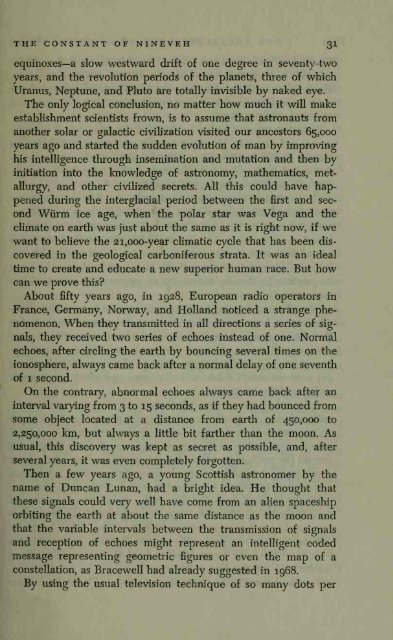You also want an ePaper? Increase the reach of your titles
YUMPU automatically turns print PDFs into web optimized ePapers that Google loves.
THE CONSTANT OF NINEVEH<br />
3I<br />
equinoxes—a slow westward drift of one degree in seventy-two<br />
years, and the revolution periods of the planets, three of which<br />
Uranus, Neptune, and Pluto are totally invisible by naked eye.<br />
The only logical conclusion, no matter how much it will make<br />
establishment scientists frown, is to assume that astronauts from<br />
another solar or galactic civilization visited our ancestors 65,000<br />
years ago and started the sudden evolution of man by improving<br />
his intelligence through insemination and mutation and then by<br />
initiation into the knowledge of astronomy, mathematics, metallurgy,<br />
and other civihzed secrets. All this could have happened<br />
during the interglacial period between the first and second<br />
Wiirm ice age, when the polar star was Vega and the<br />
climate on earth was just about the same as it is right now, if we<br />
want to believe the 21,000-year climatic cycle that has been discovered<br />
in the geological carboniferous strata. It was an ideal<br />
time to create and educate a new superior human race. But how<br />
can we prove this?<br />
About fifty years ago, in 1928, European radio operators in<br />
France, Germany, Norway, and Holland noticed a strange phenomenon.<br />
When they transmitted in all<br />
directions a series of signals,<br />
they received two series of echoes instead of one. Normal<br />
echoes, after circling the earth by bouncing several times on the<br />
ionosphere, always came back after a normal delay of one seventh<br />
of 1 second.<br />
On the contrary, abnormal echoes always came back after<br />
interval vaiying from 3 to 15 seconds, as if they had bounced from<br />
some object located at a distance from earth of 450,000 to<br />
2,250,000 km, but always a little bit farther than the moon. As<br />
usual, this discovery was kept as secret as possible, and, after<br />
several years, it was even completely forgotten.<br />
Then a few years ago, a young Scottish astronomer by the<br />
name of Duncan Lunan, had a bright idea. He thought that<br />
these signals could very well have come from an alien spaceship<br />
orbiting the earth at about the same distance as the moon and<br />
that the variable intervals between the transmission of signals<br />
and reception of echoes might represent an intelligent coded<br />
message representing geometric figures or even the map of a<br />
constellation, as Bracewell had already suggested in 1968.<br />
By using the usual television technique of so many dots per<br />
an

















